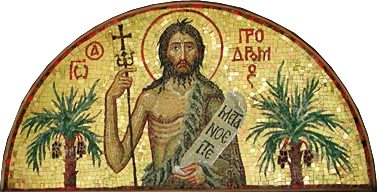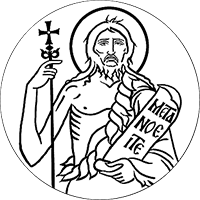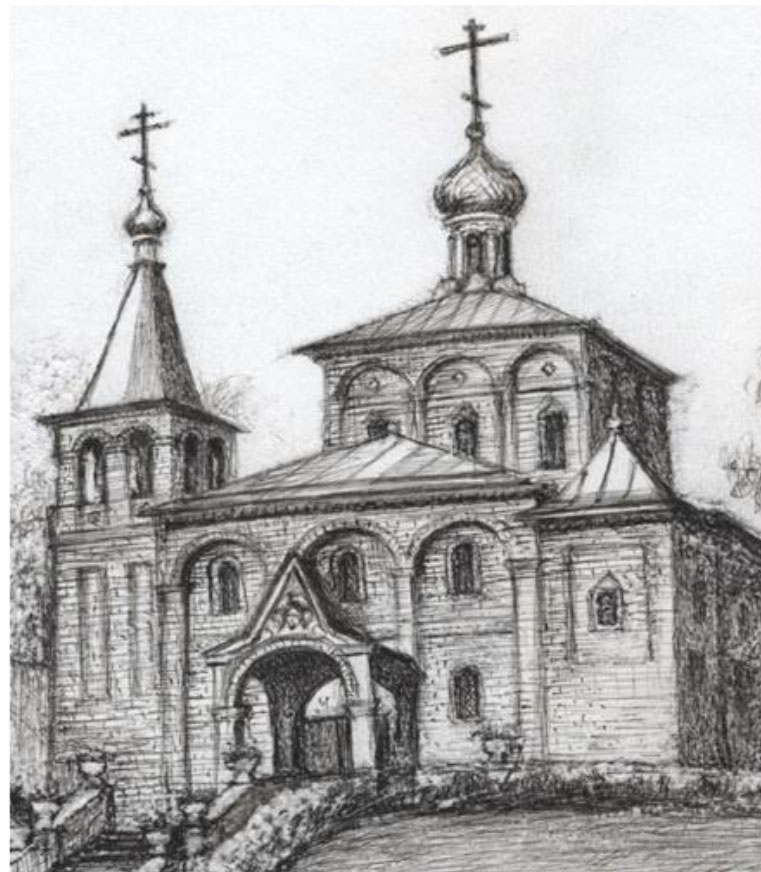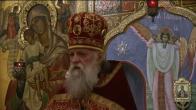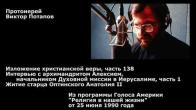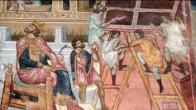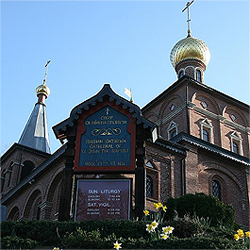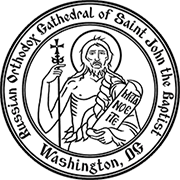Иосиф Муньос-Кортес
Jose Munoz-Cortez
- Jose Munoz-Cortez (1950-1997) The Chosen One of the Mother of God
- Icon of Brother Joseph
- Interviews with Brother Joseph
- The trial of the murderer of Brother Joseph Munoz-Cortes
- Reactions to Brother Joseph's Murder
- Pilgrimage to Brother Joseph's Grave
- Remembering Brother Joseph
- Accounts of Miracles from the Iveron Myrrh-streaming Icon of the Mother of God and Brother Joseph
- Videos about Brother Joseph
- A new copy of the Montreal Iveron Icon of the Mother of God
Iveron Myrrh-Streaming icon of the Mother of God
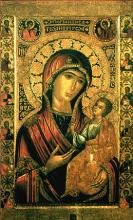 The Iveron Icon, which at present is preserved in a monastery on Athos, by tradition was painted by the Apostle and Evangelist Luke. In November 1982, a copy of the Iveron Icon of the Mother God began to stream myrrh in Canada. In 1983, the Icon was in Washington for the first time, and I then asked its guardian - the Spaniard José Muñoz - how he had received the Holy Object, and when it had begun to stream myrrh. Here are his own words, which were recorded during our conversation with him:
The Iveron Icon, which at present is preserved in a monastery on Athos, by tradition was painted by the Apostle and Evangelist Luke. In November 1982, a copy of the Iveron Icon of the Mother God began to stream myrrh in Canada. In 1983, the Icon was in Washington for the first time, and I then asked its guardian - the Spaniard José Muñoz - how he had received the Holy Object, and when it had begun to stream myrrh. Here are his own words, which were recorded during our conversation with him:
"Once during our pilgrimage on Athos, after several hours of walking, we got lost. It began to get dark. We needed quickly to find shelter for the night. Going along a path, we stumbled upon a small, poor scete. There the fourteen Greek monks of the scete were engaged in iconography. They received us very cordially. Having rested a little, we began to examine the icons of their work. One of my fellow-travellers, who spoke Greek, got into a conversation with the monks and told them who and from where we were. I, though, taking advantage of the mo-ment, began more attentively to examine everything round about. Suddenly my gaze stopped at an icon of marvellous artistry with dimensions of approximately fifteen by twenty inches. I asked a monk if he could not sell it to me. He refused me, having explained that that image was the first which had been painted in that scete and therefore would not be sold. I could not tear my eyes from that wondrous icon. We stayed the whole night in the scete and in the morning stood through the Liturgy. During the singing of "It is truly meet", I begged the Queen of Heaven on my knees to let the Holy Image go with me... Bidding farewell in the morning, all the monks accompanied us, but the hegoumen was not among them. And then at the last minute before our departure from the monastery we saw him: he quick descended the staircase with the wrapped-up icon in his hands. He came up to me and said: "Take it. I am gifting it to you. It must be with you." I offered to pay for the icon, knowing that the monks were needy; but the hegoumen said severely: "One must not take money for such a holy object!" I crossed myself, kissed the image and made a vow to myself that that image would never become the source of my enrichment....
"After this, we set out at once for Iveron Monastery in order to receive the superior's blessing and to touch the icon received by me to the Original, which is preserved in this famed monastery. But far from everyone is allowed to approach and permitted to touch the ancient Wonderworking Icon. Glory be to God, we were permitted! In the chapel, we knelt and, gazing at the holy object, froze in prayer before the image of the Iveron Mother of God. The image was so majestic, so shiningly beautiful and radiated such spiritual power that it was difficult to gaze at it for long! A hieromonk helped me touch my copy to the Original.
"Soon after this we went home to Canada. We returned on 3 November 1982. I put the icon next to the relics of the saints of the Kiev Caves Lavra and the New-martyr Elizabeth Feodorovna, which had been received by me from the reposed Archbishop Leonty of Chile. A lampada flickered before it all the time, and each day before sleep I read Akathists to it. On the 24th of November, I was awakened at three o'clock in the morning by the powerful aroma of roses - the whole room was filled up by it. At first I thought that it emanated from the relics or from a spilt vial of perfume; but, on approaching the icon, I was struck! The whole icon was covered with oil - a fragrant oil! I froze on the spot at such a miracle!"
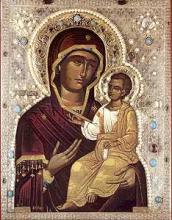 Soon after the beginning of the Iveron Icon's myrrh-streaming, news of it spread instantaneously around all the parishes of the Russian Church Abroad and other Orthodox Churches. Since 1982, the Icon has visited Orthodox parishes in many countries of the world. At the end of 1995, it was in Bulgaria, where more than sixty thousand of the faithful prayed before it, and each was individually anointed with its holy oil. Everywhere it has brought comfort and, by the prayers of the faithful, miracles.
Soon after the beginning of the Iveron Icon's myrrh-streaming, news of it spread instantaneously around all the parishes of the Russian Church Abroad and other Orthodox Churches. Since 1982, the Icon has visited Orthodox parishes in many countries of the world. At the end of 1995, it was in Bulgaria, where more than sixty thousand of the faithful prayed before it, and each was individually anointed with its holy oil. Everywhere it has brought comfort and, by the prayers of the faithful, miracles.
The Myrrh-streaming Icon of the Iveron Mother of God
February 12/25, Bright Tuesday, October 13/26
November 11/24 ("Montreal" Icon)
Rejoice, Keeper of the Portal most gracious,
who dost open to the faithful the doors of Paradise
(Akathist refrain)
The Tradition
The original Miraculous Icon of the Iveron Mother of God is on Mount Athos, the famous center of Orthodox monasticism (known also as Agion Oros - Greek for the "Holy Mountain"). By tradition, it was painted by the apostle and evangelist Luke.
In the 9th century, this Icon was in the possession of a widow who lived in Nicea. This town in Asia Minor no longer exists, but in its time it was the venue for two Ecumenical Councils; the first, which composed the first eight articles of Nicean Creed, and the seventh, which reinstituted the veneration of icons after a lengthy struggle with the iconoclast heresy, which had erroneously equated the veneration of icons to idol worship.
It was during the reign of the iconoclast Byzantine emperor Theophilus that soldiers came to the house of the widow, where in a small chapel the Iveron Icon of the Mother of God occupied a place of honor. One of the soldiers struck the Icon with his sword, and immediately blood began to flow from the gashed cheek of the Virgin. Shaken by this miracle, the soldier instantly repented, renounced the iconoclast heresy, and entered a monastery. On his advice, the widow concealed the Icon in order to avert its further desecration. After praying for guidance before the Icon, the widow put the Holy Image into the sea. To her immense surprise and joy the Icon did not sink but, remaining upright, drifted away in a westerly direction. Fleeing persecution, the widow's son left Nicea and went to Mt. Athos where he led a saintly life as a monk to the end of his days. There he recounted the story of how his mother had set the Holy Icon upon the waves, and this story was handed down from one generation of monks to another.
Many years later this Icon appeared on the Holy Mountain ("in a pillar of fire" as Athonite tradition recounts) from the sea, close by the Iveron monastery. At that time the holy monk Gabriel was one of the brotherhood in this monastery. The Mother of God appeared to him in a vision and directed him to convey to the abbot and brothers of the monastery that She wished them to have Her Icon as their help and salvation. She told Gabriel to approach the Icon on the waters without fear and take it with his hands. Obedient to the words of the Mother of God, says Athonite tradition, Gabriel "walked upon the waters as though upon dry land," took up the Icon and brought it back to the shore. The icon was then brought into the monastery and placed in the altar. On the next day the Icon disappeared from the sanctuary, and was found on the wall beside the monastery gate. It was returned to the altar, but the next day it was again found by the gate. This recurred several times, until the the Holy Virgin revealed to the monk Gabriel that it was not Her wish for the Icon to be protected by the monks, but that She wished to protect them. After this, a church was built near the monastery gate where the Icon resides to this day. In connection with the name of the monastery the Icon came to be known as the "Iveron" Mother of God, and because of its location, the "Portaitissa," or "Gatekeeper." In addition to many miraculous hearings, the Holy Virgin demonstrated Her protection of the Iveron Monastery during various assaults by Saracen pirates.
News of this wonder-working Icon reached Russia through pilgrims who had visited Mt. Athos. In the 17th century Archimandrite Nikon of Moscow (later to become Patriarch) asked the abbot of the Iveron monastery to send a copy of the Icon to Russia, and this request was fulfilled. The copy of this Icon also began to work miracles and a special chapel was built for it next to the Kremlin walls in Moscow, where it was especially revered by the Russian people until the Revolution of 1917. The chapel was destroyed by the Bolsheviks and the fate of the Icon is not known.
The Contemporary Miracle
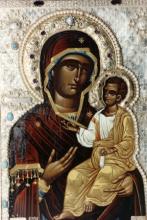 In 1982, a Chilean convert to Orthodoxy, Jose Munoz, in the company of two friends, embarked from Canada to the ancient bastion of Orthodox monasticism, Mt. Athos, on a pilgrimage. An art teacher by profession, he is also an iconographer, and therefore wished to visit some of the sketes (small monastic communities dependent upon one of the 20 major monasteries of Athos) and monasteries which specialize in icon painting. One of the friends who had accompanied Jose decided to become a monk and remained on Mt. Athos in one of the smaller sketes; Jose and his other companion directed themselves towards the Danilov skete, where icons are painted in the ancient Byzantine style using the egg tempera technique.
In 1982, a Chilean convert to Orthodoxy, Jose Munoz, in the company of two friends, embarked from Canada to the ancient bastion of Orthodox monasticism, Mt. Athos, on a pilgrimage. An art teacher by profession, he is also an iconographer, and therefore wished to visit some of the sketes (small monastic communities dependent upon one of the 20 major monasteries of Athos) and monasteries which specialize in icon painting. One of the friends who had accompanied Jose decided to become a monk and remained on Mt. Athos in one of the smaller sketes; Jose and his other companion directed themselves towards the Danilov skete, where icons are painted in the ancient Byzantine style using the egg tempera technique.
After eight hours of climbing uphill on rough terrain, they were very tired and decided to stop at a skete which they could see on the the Mountainside below. This skete, dedicated to the Nativity of Christ, is very poor and its 14 monks keep a strict monastic rule. The abbot, Fr. Klimentos, greeted them warmly and offered traditional Athonite hospitality. Then he took them to see the skete's icon-painting studio.
As soon as he entered the studio, Jose felt an immediate and indescribable attraction to a copy of the Iveron Icon of the Mother of God which hung on one of the walls. As he later explained, his heart felt as though it had 'leaped or turned over. " He asked whether he could buy this Icon, but was told repeatedly that it was one of the first icons which had been painted at this skete ( by one Fr. Chrysostomos in 1981) and was not for sale at any price.
That night at a divine service in the church of the skete, during the singing of the angelic hymn to the Theotokos "It is Meet" (one of the chief prayers of the Orthodox Church to the Mother of God), Jose fell to his knees and begged the Mother of God to make it possible for him to take the Icon back with him into the world, where "we have need of You." Immediately he felt an assurance that somehow his prayer would be answered. The next morning, as Jose and his friend were about to depart, the abbot appeared holding the Icon and said to Jose that it pleased the Mother of God for Her Icon to go with him to North America.
Jose and his companion went down the mountain and took the the boat towards Daphne, a port on the western shore of the peninsula. On the way, Jose heard a strong inner voice which bade him: "Go to the Iveron monastery and touch your Icon to the original wonder-working Iveron Icon." This they did.
Upon arrival at the Iveron monastery they waited three hours before a monk came to open the church which houses the original "Portaitissa." Jose asked that the protective icon case be opened so that his Icon could be placed upon the original Portaitissa in order to be directly blessed by the Mother of God. The monk was suprised, but agreed to Jose's request when it was explained to him that Jose and his companion wished to take the blessing of the Mother of God to the West where Her intercession is much needed.
Returning to his home in Montreal, Canada, Jose placed the Iveron Mother of God in his icon corner, where he also kept relics of the saints from the Kiev Caves monastery and of the Grand Duchess Elizabeth (one of the New Martyrs of Russia).
Jose began to read a daily Akathist (hymns of praise) before his newly-acquired Icon. At about 4 a.m. on Nov. 24, 1982 (three weeks after his return from Mt. Athos), Jose woke up to the smell of a very strong fragrance, as though someone had spilled a bottle of exquisite perfume. He thought at first that the fragrance emanated from the relics but later, when he stood before the Icon to say his morning prayers, he saw that the hands of the Mother of God were streaked with oil. Jose assumed that a friend who was sharing the house had spilled some oil onto the Icon while adjusting the flame of the vigil lamp hanging before it, but the friend denied touching the lamp. When Jose wiped the Icon, he discovered that it was the source of the wonderful fragrance which had by now filled the whole house.
Upon the advice of a local Orthodox clergyman, the Icon was taken to church and placed on the altar. During the entire liturgy, myrrh flowed from the hands of the Christ Child. Since that time, with the exception of several days during Holy Week, when the Icon is absolutely dry, the myrrh has continued to flow almost uninterruptedly. (Holy Myrrh is a sweet, fragrant oil which was used in the Old Testament for the anointing of kings. In contemporary Orthodox church practice, a newly born Christian is anointed with Holy Myrrh during which the words "The seal of the gift of the Holy Spirit" are said by the priest.)
In the years since, Jose has traveled to many cities and parishes where the Icon has been venerated to the great joy and consolation of the faithful.
Wherever the Icon goes, there are always many questions. Some people initially have doubts. A scientist in Miami was astounded to see that the back of the Icon remained perfectly dry. He later surreptitiously chipped off a small piece of the board on which the Icon is painted for scientific analysis: it was found to be ordinary pine wood, nothing more.
At some times the myrrh flows in greater abundance than at others. During the consecration of a bishop in Montreal there was such an outpouring of the myrrh, that it streamed down from the analogion (lectern on which icons are kept in Orthodox churches) onto the floor. On another occasion, in Florida, the myrrh was seen to rise forth from the hands of the Mother of God and the Christ Child as though it were being pressed from within. Nobody has any power to regulate the flow of the myrrh, it moves to the will of God and His Most Pure Mother.
The Icon is kept in a frame about two inches deep and measures about 12 X 18 inches. At first the myrrh flowed only from the hands of the Mother of God, from the star on Her left shoulder and, occasionally, from the hands of Our Lord Jesus Christ. Yet in March 1985, during a Lenten service, even the frame and glass of the Icon began to exude myrrh in such quantities, that the cloth of the analogion on which it lay was totally saturated. There is always a layer of cotton wool at the base of the Icon to absorb the myrrh: pieces of this cotton are distributed to the faithful.
Although there have already been several cases of physical healing (not only among Orthodox, but Catholics and Protestants, too), the purpose of the Mother of God seems to be directed more at the healing of souls. Many who have stood before the Icon have testified to this, experiencing not only compunction and repentance, but consolation at the same time.
As mentioned earlier, the flow of myrrh ceases during Holy Week. It ceases on Holy Monday. After the liturgy on the morning of Great Saturday, a light dew of myrrh forms on the Icon, its case and protecting glass. During Matins (the midnight service at which the glorious Resurrection of Our Lord is proclaimed), when the procession of clergy and faithful, holding icons and banners, leaves the church, the Icon begins to exude myrrh in such quantities, that it covers the hands of the person who is carrying it.
This is not the first time that the Orthodox Church has witnessed such a miracle. In the 19th century the Surety-of-Sinners Icon in Moscow exuded myrrh with which the sick were anointed and received healing. Earlier, there was a myrrh-streaming icon of the Mother of God in the Tolga monastery in Yaroslavl, and there have been others.
What is the meaning of this extraordinary manifestation of God's grace in our time? It has been observed that in the history of the Church such miracles have occurred in times of great tribulation; we saw this in the Apostolic times, and, more recently, in Russia, where the Church has suffered cruel persecution for 70 years. The miracles strengthen the faithful and prepare them to endure trials. The appearance of the myrrh-streaming Icon in our time may well signify a period of further great trials for the Russian Orthodox Church and, at the same time, offer consolation that the Mother of God will be a Protectress of the faithful: Unto whomsoever much is given, of him shall much be required.
Least Among the Brethren
 Jose Munoz formed the desire to become a monk while still a boy in Chile. He became converted to Holy Orthodoxy as a youth and began to lead a monastic life as best he could within the confines of the world, although he did not enter a monastery. Later he moved to Canada and continued to observe this way of life. When the miracle of the myrrh-streaming occurred, Jose vowed that he would never seek worldly gain from the Icon. Therefore any collections taken up during church services at which the Icon is present are sent to the poorest monasteries and sketes on Mt. Athos and/or to help those persecuted for their faith in the Soviet Union and their families. Jose never accepts any money for himself while traveling with the Icon, although he is forced to take much time off from his teaching and icon painting, which are his only sources of gainful employment.
Jose Munoz formed the desire to become a monk while still a boy in Chile. He became converted to Holy Orthodoxy as a youth and began to lead a monastic life as best he could within the confines of the world, although he did not enter a monastery. Later he moved to Canada and continued to observe this way of life. When the miracle of the myrrh-streaming occurred, Jose vowed that he would never seek worldly gain from the Icon. Therefore any collections taken up during church services at which the Icon is present are sent to the poorest monasteries and sketes on Mt. Athos and/or to help those persecuted for their faith in the Soviet Union and their families. Jose never accepts any money for himself while traveling with the Icon, although he is forced to take much time off from his teaching and icon painting, which are his only sources of gainful employment.
When asked why he thinks he was chosen for such a miracle, Jose replies that, knowing his many weaknesses, he is at a loss to explain this; he feels that perhaps it was because God often reveals himself through the very least of His servants, and that as a convert, he feels himself to be the "least among the brethren." He regards himself not as the owner, but merely the custodian of the Icon, which properly belongs to the entire body of the faithful. From his childhood his mother, who is a devout Roman Catholic, taught him to love the Most Pure Virgin, therefore he always prayed to Her, though never asked Her for any signs or miracles.
Glory be to Our Lord Jesus Christ for manifesting through Jose, the 'least of His servants," the wonder-working Iveron Icon of the Mother of God!
Washington, D.C. 1995
PARISH LIFE
RECENT VIDEOS
Address of our Cathedral
Subscribe to our mailing list
While all the materials on this site are copyrighted, you may use them freely as long as you treat them
with respect and provide attribution on the Russian Orthodox Cathedral of St.John the Baptist of Washington DC.
